

Zoe Black
Mata Aho
Mata Aho is a collective of four Māori artists based in Aotearoa New Zealand. Together they create large-scale sculptural installations rooted in Māori practices and visual forms. Coming together in collaboration enables them to tackle ambitious projects bigger than their individual capacities.
The Māori proverb ‘He taura tangata e kore e motu’ likens the connection between people to a braided taura, or rope. Traditionally, taura is made by intertwining multiple strands of muka, flax fibre. Muka is a delicate thread that can be exposed by stripping the green outer layer of the flax skin, revealing the precious pale inner fibre. Individual strands of muka are vulnerable but, when plaited, the rope they form is tough and strong.
Mata Aho is a collective of four Māori artists based in Aotearoa New Zealand, Erena Baker (Te Atiawa ki Whakarongotai, Ngāti Toa Rangātira), Sarah Hudson (Ngāti Awa, Ngāi Tūhoe), Bridget Reweti (Ngāti Ranginui, Ngāti Te Rangi) and Terri Te Tau (Rangitāne ki Wairarapa).1 The collective formed in 2011 after meeting at a wānanga, an educational meeting, where they connected through ideas and ways of making. Like taura, by coming together and working collaboratively they have been able to devise ambitious projects and create works that are ‘bigger than our individual capabilities’.

I have only seen one work by Mata Aho in the flesh. It was Tauira (2018), installed specifically for the Dowse Art Museum in Lower Hutt, Aotearoa New Zealand. Conceived in relation to the first work they made together, Te Whare Pora2, Tauira speaks to Mata Aho’s reflection on Te Ao Marama, the world of light and the pathway to greater knowledge. It consisted of multiple lengths of industrial marine rope, anchored to the floor then woven together across the gallery to flow out through a small opening and into the front window space of the building. The scale of the rope lengths amplified the weaving techniques, highlighting the different forms and patterns such as māwhitiwhiti, a crossover stitch. The title in te reo Māori, the Māori language, is the name given to a small sampler of work showcasing particular skills and also translates to 'student’ and ‘teacher’, acknowledging the group’s process of constantly learning together, of experimenting with new models, materials and techniques.3
Tauira was impressive to view, not just for the size and scale of the work, but the way in which the collective’s ideas were so perfectly reflected in the final installation. Standing in the presence of Tauira, you could sense the dedication each of the four artists had brought to the installation and the completion of a work that would have been inconceivable as an individual. The collective’s commitment, practice, understanding and determination could be felt in the work, the installation quietly reflecting the strength of the makers, working as one to achieve something monumental.
Mata Aho has been included in a number of international exhibitions including documenta14 in Kassel in 2017 and the Honolulu Biennial in 2019. The works the collective have presented continue the ways of making inherent within Tauira, namely large, fibre-based installations that are visually compelling and could be appreciated purely for the aesthetic beauty and physical presence they have in a space. However, as with the layered understanding of Tauira, Mata Aho has continued to devise installations that have a multiplicity of meaning, intelligently conveying ideas essential to Māori wāhine, Māori women, living in Aotearoa New Zealand today. These ideas primarily relate to the acknowledgement and empowerment of women, recognising their contributions and achievements that are constantly undervalued, alongside the importance of whānau, extended family, and working collectively.
Much of your work involves labour intensive techniques that you increase in scale to become even more impressive. These include techniques inherent to craft, bringing a compelling tension between domestic making practices and working on a monumental scale. How did this methodology come about?
'This methodology came about during our first project together in 2012, Te Whare Pora at Enjoy Contemporary Art Space in Pōneke Wellington, Aotearoa New Zealand. We found ourselves making an artwork about the conceptual foundations of weaving without actually weaving. Te Whare Pora is a customary teaching and learning system, which loosely translates to a house of learning particularly pertaining to fibre arts. We researched and used the skills we did have to re-present concepts that we wanted to highlight, uplift and celebrate. In particular these were concepts pertaining to women as makers. We very quickly embraced our four brain, eight hand advantage and figured out we could create works that are on a scale that we wouldn’t even attempt in our individual practices. Honouring what might be considered a domestic practice by upscaling it and taking up as much space as possible is a physical embodiment of power.'
Alongside incorporating techniques that are found in craft, you also include Māori making practices and visual forms. Has there ever been a hesitation in bringing these practices into a contemporary art space or interpreting them in ways away from how they are traditionally used?
'Innovation is a long-held Māori custom. Researching, learning and making work inspired by Māori practices and visual forms is inherent to our practice. Exhibiting work within contemporary art spaces where there may be few Indigenous employees does create a moment of hesitation. We came together as a collective because we felt elements of misunderstanding or intimidation about engaging with western art institutions as young Māori women working with concepts of Māori culture. This is where our collective strength is vital as every element we bring into a gallery is purposeful and extensively considered. The blessing/curse of being Indigenous artists is that you represent your entire peoples right? And as a collective we have an even bigger pool of family, friends and networks that we directly ‘bring’ with us to a gallery.
Visual art is an integral part of Māori expression, we have always used conceptual visual language to convey complex narratives and knowledge systems. It makes sense for us that our exploration of these customary practices sit in contemporary art spaces.'
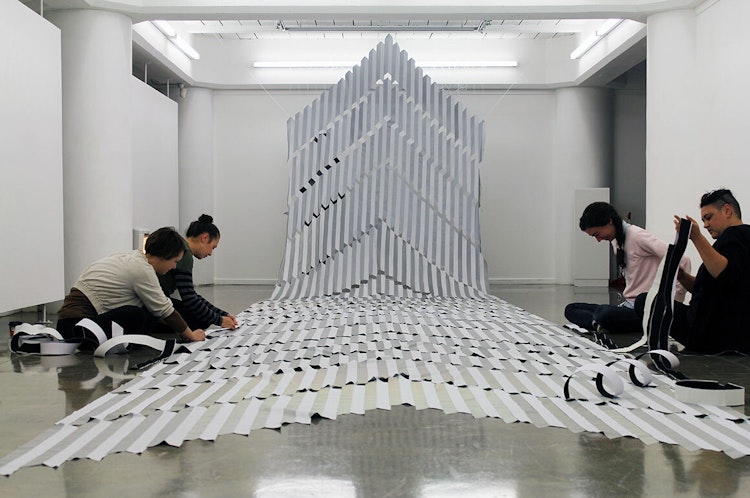
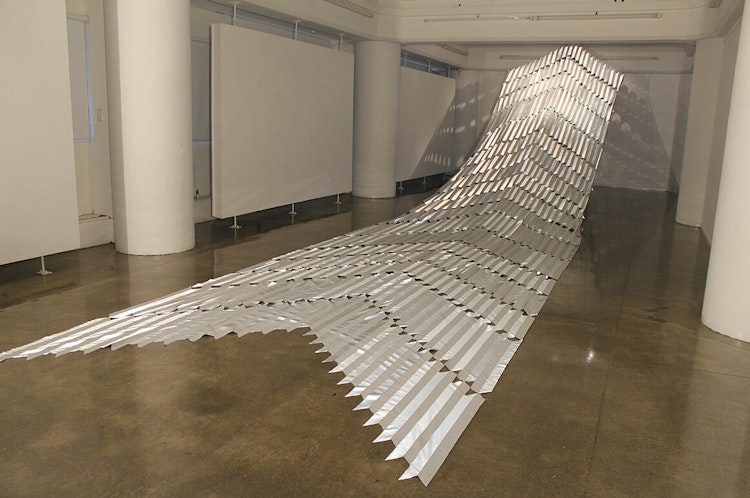
I find the way you reinterpret these ideas one of the most exciting things about your work – for example how you bring together customary Māori knowledge and patterns with modern materials, selecting ubiquitous fabrics that are commonplace in many every day and domestic spaces, including the marae, a sacred place where Māori people gather.
Kaokao (2014) is a beautiful example of this. This large-scale installation was created using reflective tape, usually found on building sites or applied as a security mechanism on clothing. The tape was woven to form a specific tukutuku, decorative latticework panels, pattern, called kaokao, that is representative of both strength and new life and is a common pattern for traditional birthing mats. The pattern is also reminiscent of military chevron, used to denote prestige and power. In the installation the reflective tape works with the kaokao pattern as a symbolic representation of the invisibility of women, particularly Māori women within wartime histories and the voices that are systematically side-lined during contested moments in time.
How do you decide on the materials you use? What is at play when you select them?
'One way we’ve found to mitigate this duality of Indigenous art in Western art institutions is through materials. We use materials that are usually cheap, accessible and ubiquitous amongst our communities. This way if our families come into the gallery and recognise nothing else – they can see our work and know the material. Hopefully this familiarity is an ‘in’ to our work and the concepts that form it. We all really enjoy the aesthetics of industrial materials; textiles that are made to function in a certain way or fibres that are created to perform a particular task. The colours of these types of materials are typically high visibility, for safety and their makeup is usually strong, in anticipation of a long hardy life outdoors. We draw from the visual language of materials that labourers might use. The labourer work force in Aotearoa is made up of Indigenous and minority cultures. By using these materials we recognise and acknowledge the people who use them every day.'
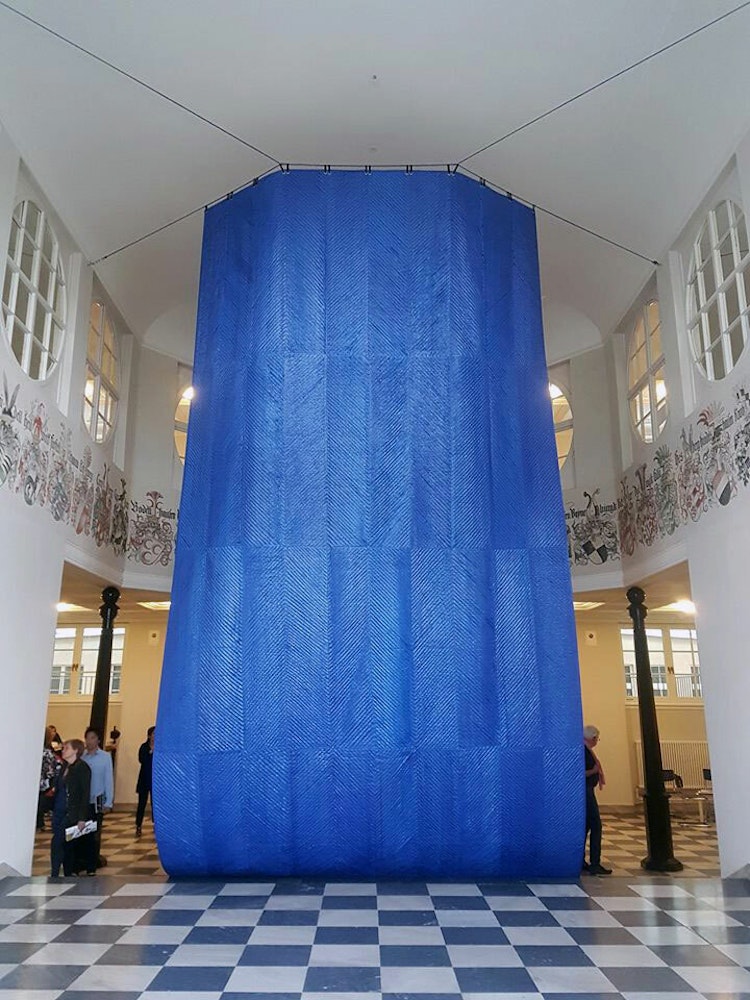
Kiko Moana (2017) communicates this acknowledgement of familiar materials in the most audacious way. The work (11m x 4m), devised and presented first at documenta14, was created using cheap, rudimentary blue tarpaulin. This most basic form of shelter was transformed into a taonga, a treasured object, gracefully circumventing the hierarchy of materials with the hands of the artists imbuing these foreign yet familiar fibres with mauri, essential force, and life.
You also embrace digital platforms in your practice, seen specifically in Kiko Moana and the complementary online collection of Taniwha Tales. Do you see digital ways of working as something that you will continue to embrace?
'We each live in different parts of Aotearoa, communicating online makes a lot of sense for us. When we’re working on a project, we use our Instagram page as a type of public workbook for documentation. We all have access and contribute collectively. Our Instagram documentation is sometimes the only way people from Aotearoa get to see our international installations. A part of our Instagram was acquired by Te Papa Tongarewa, our national museum, as it was seen as intrinsically connected to the physical sculpture of Kiko Moana, this was the first time Te Papa had collected part of an Instagram account.4 Instagram documentation of our recent work AKA, installed at the National Gallery of Canada5, also led to our nomination for one of New Zealand’s leading art prizes, The Walters Prize 2020. It was the first time an artwork has been nominated where none of the selection panel had seen the work in real life, as none of them were present in Canada, it was selected as a finalist purely from what the panel had seen online. Presenting our practice online works in many ways and we look forward to developing new ways to engage online in the future.'
Te Whare Pora relates to the atua (deity) Hineteiwaiwa, who holds authority over the arts pursued by women, specifically weaving. She is also the guardian of childbirth, an important navigator for motherhood and the transmission of knowledge. In the work Mahuika (2019) the Māori fire atua is referenced, who gifted the knowledge of fire to her descendants as an acknowledgement of strong female leadership. AKA (2019) was inspired by the female deity Waitiri, the personification of thunder. The centring of women’s stories continues through your work consistently, elevating female narratives and making them the focus. Is the scale in which you create purposeful to help give notice to women as important protagonists?
'As is echoed across the globe, colonisation hit us hard, and continues to systematically oppress Indigenous peoples. Colonisation affected Māori women and men differently. As male ethnographers spoke to Māori men about male things, women were and are erased, omitted and silenced. We feel not only a drive but a responsibility to take up as much space as we can to reclaim and empower Indigenous women’s voices. We hope that future generations of young Indigenous artists see the space we’ve claimed and can continue to reclaim even more.'
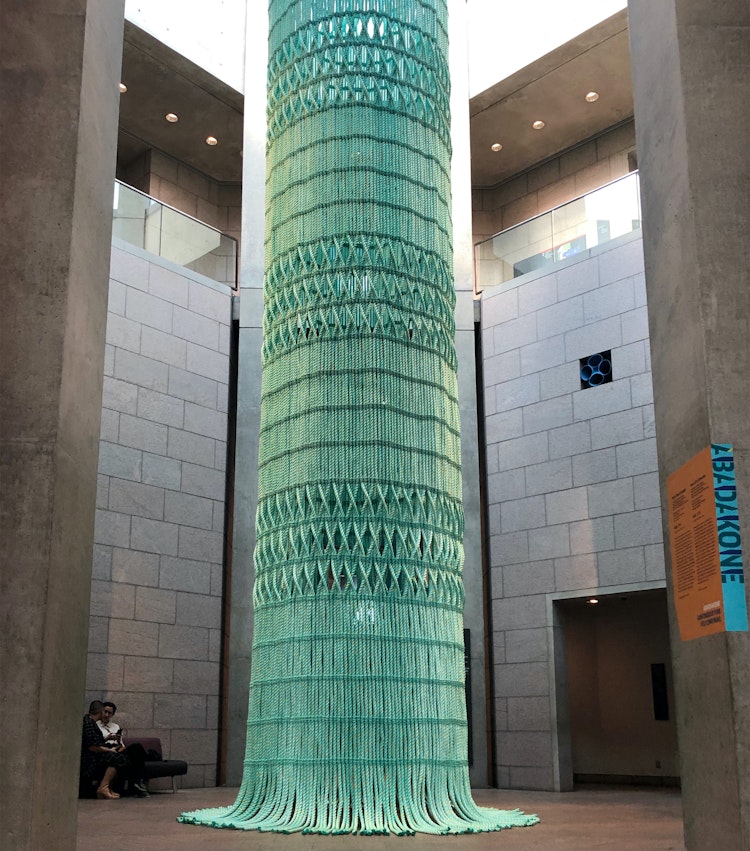

Use of the Māori language is common in the titles and descriptions of your work and often you select kupu, words, that have different meanings or terms that can’t be easily translated. For many artists, language is a political tool that can be used to indigenise a space like a gallery or museum. Is this something that is at play in your work?
'As our work is inherently developed from Māori concepts, using te reo Māori, the Māori language, to title the work is naturally an extension of portraying the world in which they were developed and produced. It is both practical and political. We don’t necessarily seek to respond to colonial constructs but rather continue to centre our own worldviews.'
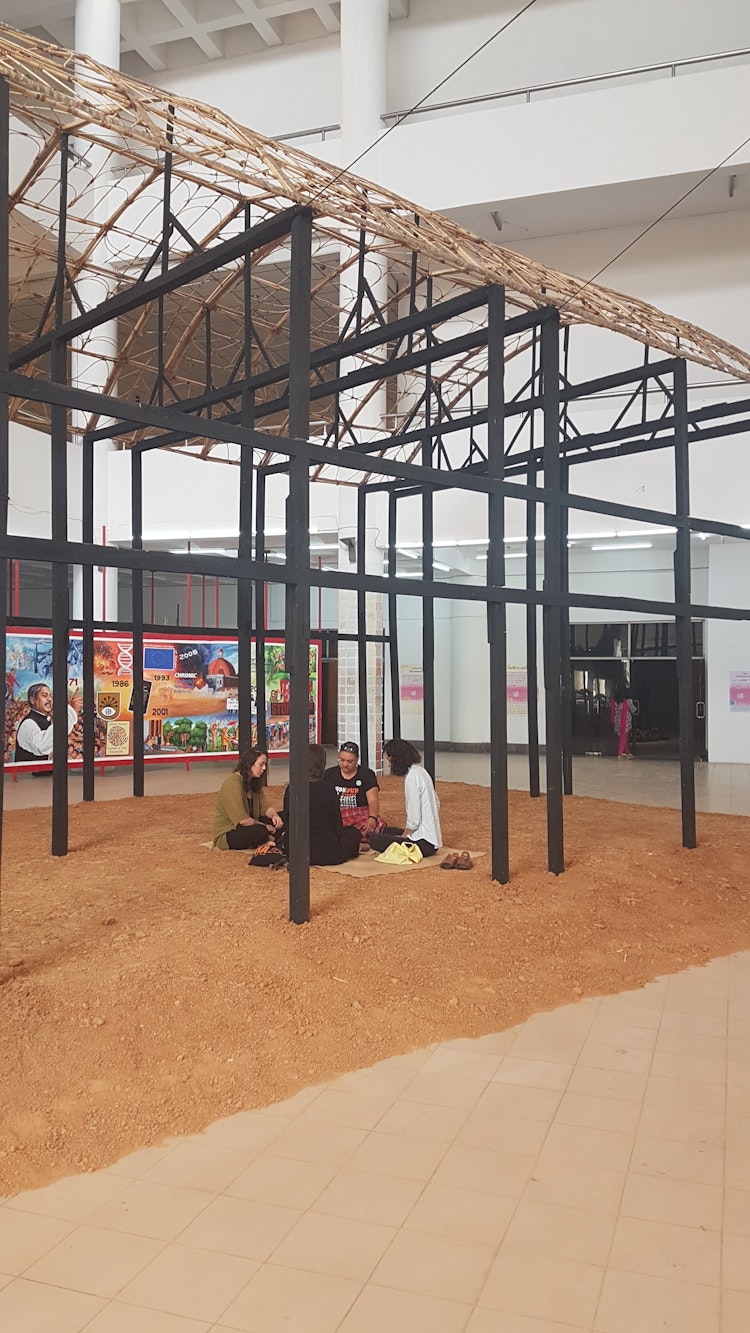
Recently you participated in the Dhaka Art Summit and contributed a different type of project, working with waiata, song, and aural traditions. What brought about this project?
'Waiata in many different forms serve many varied purposes, from celebratory to mournful – to show prowess or call someone out. In Māori culture, it’s custom to show support for speakers at formal events by singing a song after they have spoken. We each come from different iwi, tribal groups, so we always wanted a waiata that would be collectively ours. A song for us to sing in an art context when we felt it was appropriate. Over the last three years, we have been invited to participate in some large international art events that have showcased Indigenous artists from around the globe. During these events, we have been a part of some beautiful ceremonies where Indigenous people have connected through sharing an insight into their culture. Having our own pātere, chant, written for us enables us to stand and represent multiple parts of our identity and fully embody the words.'
How did the project go?
'The project felt immense, there were many layers to the work, a cultural practice, an art practice and a collective practice. We explained often that it was not a performance. Experiencing the Dhaka Art Summit was a sensory overload, the amount of art, art professionals and art audiences was beautiful and overwhelming. Our small daily practice gave us a clear focus while it was often intangible for others to engage with. Every day, for an hour, we sat under Taloi Havini’s installation named Reclamation. The floor of the installation was covered in earth, Taloi brought us a mat from a local market for us to sit on. The pātere we learnt was titled ‘Taku Aho E’ and was written for us by Te Kahureremoa Taumata, a Ngāti Kahungunu, Ngāti Tūwharetoa performer, composer of taonga puoro, musical instruments, and all-round boss Māori woman.
We practiced every day, sitting closely together, we found ourselves becoming in tune with each other’s breathing patterns. If we were to all take a breath at the same time, our chant would fall silent. We tapped into an awareness of each other’s capacity and intuitively and continuously chanted.
There were a lot of sensory distractions we had to shut out to try to memorise the pātere. As a way to combat this, we practiced with our eyes closed. This resulted in some quite earnest looking photos, but hey – we’re ok with that.
By the tenth day we could recite the pātere from memory. We are yet to use it in context, but it’s ours now to have and use when and if we feel the need.'